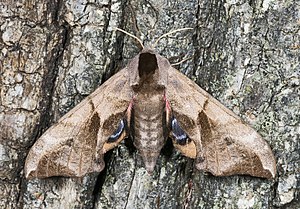Evening peacock butterfly
| Evening peacock butterfly | ||||||||||||
|---|---|---|---|---|---|---|---|---|---|---|---|---|

The moth is well camouflaged during the day |
||||||||||||
| Systematics | ||||||||||||
|
||||||||||||
| Scientific name | ||||||||||||
| Smerinthus ocellata | ||||||||||||
| ( Linnaeus , 1758) |
The evening peacock butterfly ( Smerinthus ocellata ) is a butterfly ( moth ) from the family of swarmers (Sphingidae).
features
The moths reach a wingspan of 70 to 80 millimeters. Their forewings are drawn in light and dark brown tones and look similar to the coloring of bark. They are slightly bulged and truncated on the outer edge. The hind wings are pink at the base, which flows into an ocher yellow on the outside. The hind wings are each dominated by a large, blue, dark nucleus and black rimmed eye spot . The thorax is light brown on the sides and dark brown haired in the middle.
The caterpillars are about 80 millimeters long and are mostly blue-green, rarely yellow-green. Your whole body is covered with fine white dots. The yellow side stripes that run diagonally from the bottom to the top are noticeable. The anal horn at the end of the abdomen is light blue. The back of the animals is significantly lighter than the rest of the body. As a result, they appear equally bright when sitting on the underside of branches due to their shadow all over the body. This causes them to be mistaken for a leaf, since the spatial dimensions can no longer be recognized. The caterpillars look very similar to those of the poplar hawks ( Laothoe populi ), but they have a yellow anal horn.
Occurrence
The animals are found in North Africa and all of Europe , except the far north and south of the Iberian Peninsula . To the east, their distribution area extends to Siberia . They live in damp forests and on the banks of water, sometimes in gardens. They are common and common.
Way of life
The nocturnal adults sit well camouflaged on tree trunks during the day. If they are disturbed, they spread their wings jerkily, so that you can see the eye spots on the hind wings. The body is also rocked back and forth. This combination is intended to fool a significantly larger animal and thereby deter predators.
Flight and caterpillar times
The moths fly in one generation from mid-May to July, the caterpillars are found from July to September. Sometimes one finds moths of a partial second generation in August. In the warm south, two or three generations develop in August or April / May, June / July and August / September.
Food of the caterpillars
The caterpillars mainly feed on narrow-leaved willows such as wicker willow ( Salix viminalis ), broken willow ( Salix fragilis ), ear willow ( Salix aurita ), ash willow ( Salix cinerea ) and Salix willow ( Salix caprea ) . You can also find them on poplars ( Populus ), rarely also on birches , apple trees and other fruit trees.
development
The females lay their ellipsoidal, shiny pale green eggs on the underside of the leaves of the forage plants. The animals overwinter as a pupa , about 20 centimeters deep in the ground. They dig much deeper than, for example, poplar or linden hawks , so that the pupae, which are often located close to the banks, cannot be washed away by floods. The 35 to 41 millimeter long black-brown, oily shimmering dolls are also greased to repel water.
swell
Individual evidence
- ↑ a b c Heiko Bellmann : The new Kosmos butterfly guide. Butterflies, caterpillars and forage plants. Franckh-Kosmos, Stuttgart 2003, ISBN 3-440-09330-1 , p. 90.
- ^ A b c Hans-Josef Weidemann, Jochen Köhler: Moths. Weirdos and hawkers. Naturbuch-Verlag, Augsburg 1996, ISBN 3-89440-128-1 , p. 34f.
- ↑ Manfred Koch : We identify butterflies. Volume 2: Bears, Spinners, Swarmers and Drills in Germany. 2nd, expanded edition. Neumann, Radebeul / Berlin 1964, DNB 452481929 , p. 106f.
literature
- Günter Ebert: The Butterflies of Baden-Württemberg Volume 4, Moths II (Bombycidae, Endromidae, Lemoniidae, Saturniidae, Sphingidae, Drepanidae, Notodontidae, Dilobidae, Lymantriidae, Ctenuchidae, Nolidae). Ulmer Verlag Stuttgart 1994. ISBN 3-8001-3474-8




